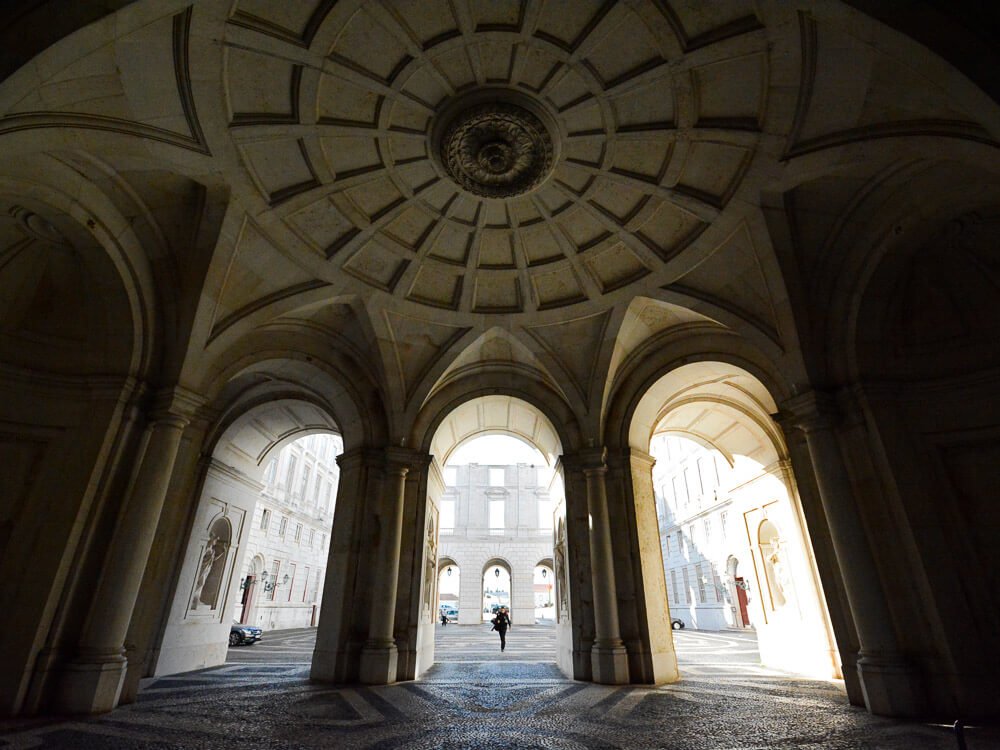If you’ve ever wondered how kings and queens once lived, Ajuda Palace is a must-visit. Come with me and find out more about this opulent royal residence and how to visit it.
On top of the highest hill of the Ajuda neighborhood, stands Ajuda National Palace (Palácio Nacional da Ajuda), the last royal palace built in Portugal. And, I must say, visiting it is a truly magical experience!
This is one of those places that manages to transport us back in time and make us feel like one of the former royal residents, all thanks to its conserved interiors and original 19th century pieces.
Ajuda National Palace is already a sight to behold by itself, but, as often is the case, I think knowing its backstory (and, trust me, it’s an interesting one!) makes seeing it with our own eyes all the more special.
That’s why I’ve decided to share everything you should know about Ajuda National Palace before visiting it, including some insider tips. Now, without further ado, let’s get into it!
Ajuda National Palace: a quick summary
- Highlights: Winter Garden, Music Room, Throne Room and the collection of decorative arts.
- Opening hours: Thursday to Tuesday, from 10am to 6pm (last entrance at 5:30pm). Closed on wednesdays, January 1st, Easter Sunday, May 1st, December 24th and 25th.
- Best time to visit: late afternoon
- Tickets/price: € 8 per person. Free for children under 12.
- Recommended duration of visit: 1h45
- Address: Largo da Ajuda, 1349-021 Lisboa
- Nearest station: Belém Station
- Bus lines: 729, 732, 742, 760 and Tram 18
Index
- Ajuda National Palace’s history
- Points of interest
- 2.1. Interior
- 2.2. Art collections
- 2.3. Architecture
- Opening hours and ticket information
- How to get to Ajuda National Palace?
- How long does it take to visit Ajuda Palace?
- Nearby attractions
- Where to stay in Ajuda?
- Is Ajuda National Palace worth a visit?

1. Ajuda National Palace’s history
As some of you may know, Lisbon’s history was greatly impacted by two major events: the earthquake of 1755 that left almost the entire city in ruins, and the transfer of the Portuguese court to Brazil. Interestingly enough, Ajuda Palace is related to both of these facts!
So, let’s start at the beginning.
Among the buildings destroyed in the morning of the earthquake was the Palácio da Ribeira, where the royals lived at the time. Even though King José wasn’t harmed in the incident, he decided to move the palace to a safer place: Ajuda Hill, the highest point in the neighborhood.
The King decided the new building should be made of wood, to make it more resistant to future earthquakes, thus came the Royal Tent (Real Barraca), which finished building in 1761. What the King didn’t know is that it wasn’t an earthquake he should be worried about…
In 1794, the wooden palace was completely destroyed by a fire (I know, I’m also shocked!). After this unfortunate event, a more durable palace in neoclassical style was conceived by architect Manuel Caetano de Sousa and, in 1796, construction of Ajuda National Palace officially began.
Now, I know what you’re thinking: when will this place finally be finished?! Well… it won’t. Until this day, only one-third of the original plans were completed, which is especially surprising once you see the sheer size of it!
Building and renovation continued until the late 19th century, but, with Portugal’s monarchy being overthrown in 1910, this historic building was closed and remained unfinished, reopening as a museum in 1968.
Occasionally, it still holds some official government ceremonies, but is usually open to visitation.
2. Points of interest
2.1. Interiors of Ajuda National Palace
King Luís I and Queen Maria Pia were the first royals to live in Ajuda National Palace, and they went all out on the decoration. From silk wallpapers to indoor plumbing with hot water and unique patterns on the wooden floors, they spared no expense.
All the rooms have original decoration and items that the family used, giving visitors a true glimpse into the past and the royals’ lives. It’s no wonder it’s the largest and most important Museum of Decorative Arts in Portugal!
Private chambers

On the ground floor, you’ll find the private chambers. Some of the highlights are:
- Music Room: a complete music room with wooden flooring, artworks, and numerous musical instruments.
- Green Room: one of the queen’s private rooms, with green silk walls and Rococo-style decoration, where Infante Carlos was born.
- Queen’s Bedroom: decorated with religious iconography, ornate wood furniture and a large canopy bed, besides blue silk on the walls and a painted ceiling.
- Pink Room: a small room in pink silk, designed to display the queen’s impressive porcelain collection.
- Winter Garden, or Marble Room: completely covered in marble, this is one of the most beautiful rooms in the palace. It’s an indoor garden, with various plants and outdoor furniture, complete with a marble fountain, bronze busts and large bird cages.
State rooms

The second floor is where you’ll find the state rooms, such as:
- Throne Room: a very large and stunning room where you’ll find the thrones of Luís and Maria Pia under a red draped canopy. The walls are covered in red silk and the painted ceiling depicts Dom Miguel.
- Supper Room: probably the most important room of the palace, as it used to (and still does!) hold state dinners and ceremonial events. It also showcases stunning 18th century Chinese porcelain.
- Chinese Room: a room decorated in natural silk, with a tent-shaped ceiling, chandeliers, red doorways with gold trims, and, of course, lots of stunning Chinese porcelain.
- Ballroom, or King John VI’s Hall: the formal ballroom, complete with an upper gallery and a very impressive painted ceiling. Red silk covers the walls and the entrance has full-length portraits of Luís and Maria.
Besides all of that, King José also commissioned a garden, known as Ajuda Botanical Garden, located right next door to the palace. After all the exploring, I’d recommend spending some time outdoors, just enjoying the peaceful setting as the monarchs once did.
2.2. Art collections

Within the palace, visitors have access to important collections of decorative arts from the 18th and 19th centuries, including gold and silver ware, paintings, sculptures, furniture pieces, tapestries, glassware, and porcelain.
Besides that, the Ajuda Palace is also home to the Royal Treasury Museum (Museu do Tesouro Real), a collection of more than a thousand unique Portuguese Crown Jewels. Visiting it does require an additional ticket, but I think it’s definitely worth it!
2.3. Architecture

Because the construction of Ajuda Palace took so long (over 150 years), it ended up being the collective work of many architects, such as Manuel Caetano de Souza, Francisco Xavier Fabri and José da Costa e Silva.
Overall, it features a mix of styles with neoclassical and late baroque elements, representing its rich historical background and unique building conditions.
Where does the Portuguese government live today? Since 1910, the official residence of Portugal’s president has been at Belém Palace, located in the Belém district. Even though most of the presidential activities happen there, the Ajuda National Palace is still used for state dinners and special events, maintaining its importance in modern government.
2. Opening hours and ticket information
The Ajuda National Palace opens at 10am and closes at 6pm, with the last entry at 5:30pm.
While it’s possible to buy tickets at the palace, I’d recommend booking ahead on their website to avoid standing in line and making sure they’re not sold out.
A ticket to the palace is € 8, while the Ajuda Botanical Garden is € 2 and the Royal Treasure Museum is € 10. Combined ticket for Ajuda Palace and the Coaches Museum is € 12. The Lisboa Card includes access to the palace.
On Sundays, Portuguese citizens and residents can visit Ajuda National Palace for free, an initiative to promote culture and art.
3. How to get to Ajuda National Palace?
No matter whether you take a bus, tram or train, getting to Ajuda Palace Lisbon is very simple. Right outside the palace, there’s a bus stop that serves lines 729, 732, 742, and 760.
Tram 18 also provides a direct route passing through Belém, and the palace is a short and easy walk from the Belém Station.
4. How long does it take to visit?
Generally speaking, a visit to the Ajuda National Palace in Lisbon takes about 1 hour and 45 minutes. With this timeframe, you should be able to walk through the main rooms with short pauses to read informational signs or use audio guides.
Those interested in a deeper understanding of Portugal’s royal past may want to spend more time at the site, especially if planning on also visiting the Royal Treasury Museum and Ajuda Botanical Gardens.

Overall, I always feel like allowing extra time allows for a more thorough and enjoyable visit, but that’s up to you!
5. Nearby Attractions
As I’ve mentioned earlier, the Ajuda Botanical Garden is right next to the Ajuda Palace, offering a peaceful place for those who enjoy quiet and scenic spots. The gardens provide views of the Tagus River and are great for a leisurely stroll.
Heading towards Belém, there are many other attractions, such as:
- Jerónimos Monastery, a World Heritage site known for its stunning Manueline architecture and cloisters.
- Belém Tower,a 16th century fortification connected to Portugal’s maritime past.
- Discoveries Monument: a tribute to Portuguese explorers.
- Coaches Museum: a collection of royal coaches from past centuries.
- Belém Cultural Center: an artistic venue that regularly hosts exhibitions, concerts and various events.
- Belém Palace: the current president residence.
- 25 de Abril Bridge: a bridge over the Tagus River that resembles San Francisco’s Golden Gate Bridge and offers great sunset views.
6. Where to stay in Ajuda?
If you’re looking for a less crowded and more authentic area to stay in Lisbon, Ajuda could be the perfect match!
The downsides are that there are fewer accommodation options, and getting to other tourist attractions might require taking public transportation, as the city center is not as close as in other neighborhoods.
However, the peace and quiet more than make up for it, as well as the great bus and tram connections. Here are my hotel recommendations:
- Wine & Books: 700m from the Jeronimos Monastery. Accommodation with fitness center, private parking, terrace, restaurant, bar and sauna.
- Famous Crows: comfortable rooms and apartments less than 200mfrom Jerónimos Monastery. Apartments with fully equipped kitchenettes.
- Hotel Jeronimos 8: adjacent to the Jerónimos Monastery, modern rooms with air conditioning. There’s also a bar, terrace and daily breakfast.
- Hyatt Regency Lisbon: a 5-star hotel with room service, restaurant and bar, located 1.4km from Ajuda Palace.
7. Is Ajuda National Palace Worth a Visit?
In my opinion, Ajuda National Palace is not just worth it, it’s actually a must-visit attraction, especially to those interested in history.
The palace reflects the historical wealth of the Portuguese monarchy, giving insights into the 19th century royal lifestyle and offering an engaging experience. What’s not to love?
So, if looking at stunning historical pieces while learning about Portugal’s rich history sounds like a blast to you, then I’m sure you’ll love visiting Ajuda National Palace.
Immerse yourself in history at Ajuda Palace

Despite its difficult construction, so often halted by economical and political reasons, and unfinished state, Ajuda National Palace is a gorgeous palace that showcases how grand projects were carried out over time.
It’s more than just a beautiful place to visit; it’s an entryway into the history of Portuguese royalty and even modern government.
That’s why this palace continues to draw attention from both locals and tourists, and the reason why you should definitely take some time to get to know its well-decorated rooms.








1 thought on “Ajuda National Palace: things to know before you visit”